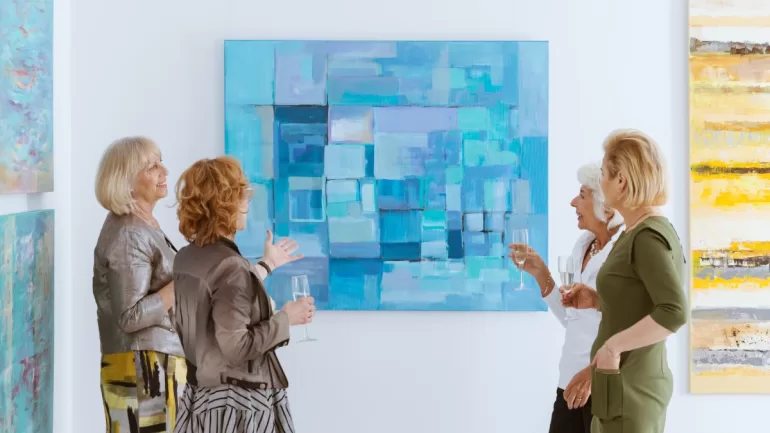GALLERIES
Turning a blank space into an elegant art exhibition is a fun challenge for any artist or event planner. It’s about elevating the art and the viewer’s experience. Whether you’re preparing for your first solo show or curating a group exhibition, knowing how to make any venue look art gallery-worthy can distinguish your event from countless others.
A memorable art exhibition hinges on venue presentation. While professional galleries perfect their spaces over the years, you can achieve similar results with smart planning and creative solutions.
Create Clean Lines With Strategic Lighting
Lighting elevates a space, turning ordinary rooms into sophisticated galleries. Track lighting, pendant fixtures, and adjustable spotlights draw attention to pieces and create depth with dramatic shadows.
Position lights at 30-degree angles to prevent glare, and use warm white LED bulbs (3000K) for accurate color rendering. We recommend avoiding fluorescent lighting, as it distorts colors. Uplighting along walls can soften the atmosphere while keeping focus on individual artworks.
Transform Spaces With Professional Draping
Using fabric draping can instantly upgrade any space, providing clean backgrounds and hiding architectural flaws. For art exhibitions, white or neutral fabrics are the way to go, as they don’t clash with the artwork. To create defined areas, especially in large, open spaces, consider hanging floor-to-ceiling draping behind the artwork.
Sheer fabrics allow natural light while elegantly separating sections. Strategic fabric placement can hide unattractive areas of a venue, such as exposed wiring, damaged walls, or outdated fixtures.
Design Dedicated Display Areas
Great venues know how to create distinct sections for different types of artwork. By using temporary walls, dividers, or furniture, you can easily separate paintings, sculptures, and interactive pieces.
To enhance the display and protect valuable art, consider these tips:
- Position larger pieces at eye level (57–60 inches from the floor to the center).
- Arrange smaller works in groups for greater visual impact.
- Leave at least 6 feet of walking space between displays.
- Use neutral pedestals to keep the focus on the artwork.
- Vary the heights and sizes of displays for added interest while ensuring clear sightlines for viewers.
Curate Color Palettes That Complement Art
Galleries often favor neutral wall colors such as white, light gray, or soft cream. These serene backdrops allow the artwork’s true colors to shine, preventing any visual distractions. If your venue has vibrant, pre-existing wall colors, you might consider temporary solutions like large fabric panels or removable wallpaper to create a neutral zone.
For venues that get a lot of use, a new coat of neutral paint could be a great investment. Keep in mind that cool tones tend to create calm and contemplative spaces, which are perfect for intricate or understated pieces, while warmer neutrals can bring out more energetic and vibrant artwork.
Incorporate Natural Elements Thoughtfully
Integrate plants and floral arrangements thoughtfully; they add life without overwhelming the art. Simple, elegant designs complement displayed pieces. Large leafy plants can soften architectural lines, while smaller arrangements can direct visitor flow.
Avoid heavily scented flowers, as their strong fragrances can be overwhelming in enclosed spaces. These living elements provide a natural, organic contrast to the clean, minimalistic lines of a gallery, especially enhancing spaces with neutral color schemes by adding visual and tactile interest.
Making any venue look art gallery-worthy requires attention to detail and understanding of how different elements work together. These techniques help create professional exhibition spaces that honor both the artwork and the viewers’ experience.
